Breast Masses in Children
by Pierre Vassallo
MD PhD FACA Artz fur Radiologie
Consultant Radiologist
Discovery of breast masses in children and adolescents oftencauses tremendous parental and physician concern because ofthe high prevalence of breast cancer in the adult population. However, the prevalence of breast cancer in this age group is low, and knowledge of the spectrum of pathologic conditions and radiological findings that affectthe pediatric breast is important in guiding management.
Breast lesions in children and adolescents are managed differently from those in adults. Unlike in adults, the initial breast imagingstudy performed in pediatric patients is ultrasound, whereasmammography is reserved for selected cases. Advantages of ultrasoundover mammography include lack of ionizing radiation in a susceptiblepopulation and greater sensitivity in the relatively dense fibroglandulartissue of young girls. Mammography has a role inthe evaluation of microcalcifications and of suspicious discretemasses in older adolescents. Also biopsy and surgical intervention are more cautiously employed in children and adolescents due the low prevalence of breast cancer in this age group and the risk of injuring the developing breast.
The onset of breast development is called Telarche and occurs in white girls at 7-8 yrs of age and about a year earlier in the black population. At telarche breast development may be asymmetrical, which may cause concern. However ultrasound can confirm normal glandular development and exclude a lesion. It is important to recognise the stages of breast development (Tanner stages 1-5, Figure 1) that are visible on ultrasound examination between the ages of 7 and 13yrs, whereby initially the ductal system is develops followed by the fibroglandular tissue and subcutaneous fat.
Premature thelarche may occur as an isolated event or as partof precocious puberty. Isolated premature thelarche generallyoccurs in girls aged 1–3 years and is nonprogressive.Reassurance is all that is required. However, if the patienthas clinical evidence of other forms of sexual maturation, suchas axillary and groin hair growth or vaginal bleeding, a work-upfor precocious puberty should be pursued. Radiologic evaluationfor suspected precocious puberty should include a bone age assessmentand abdominal and pelvic ultrasound to look forevidence of maturation of the uterus and ovaries. In addition,the ovaries and adrenal glands should be evaluated for oestrogen-producinglesions, including functioning ovarian cysts, juvenile granulosacell tumors of the ovary, and rare feminizing adrenal corticaltumors.
Excessive development of the male breast is called gynaecomastia and clinically manifests as tender, firm subareolar nodules. Inchildren, gynaecomastia often occurs during the neonatal periodand puberty. Bilateral enlargement of the breasts is commonin neonates because of the influence of maternal hormones. At puberty, two-thirds to three-fourths of boys have some degreeof breast enlargement, which peaks at age 13–14 yearsand usually resolves within 2 years. The conditionis usually bilateral but may be unilateral, and it may be familial.The aetiology of gynaecomastia is thought to be a decrease inthe ratio of testosterone to oestrogen. Excessive body fat maylead to increased conversion of testosterone to oestrogen. Excessive and more rapidly progressive gynaecomastia or development of gynaecomastia in a prepubertalboy suggests the presence of an endocrinopathy or other underlyingdisease. Uncommon causes of gynaecomastia include oestrogen-producingtumors of the testis, such as Sertoli or Leydig cell tumors;rare, feminizing adrenal cortical tumors; gonadotropin-secretingtumors, such as hepatoblastoma and fibrolamellar carcinomaor choriocarcinoma; prolactinomas; liver disease; Klinefeltersyndrome; testicular feminization syndrome; and neurofibromatosistype 1. In addition, use of drugs such as marijuana (Figure 2), anabolicsteroids, corticosteroids, cimetidine, digitalis, and tricyclicantidepressants can cause male breast development.
Juvenile hypertrophy, which is also known as virginal hypertrophyor macromastia, is excessive female breast enlargement thatoccurs in a relatively short period of weeks to months that often begins shortly after menarche but may occurduring pregnancy. Usually both breasts are symmetrically, diffuselyenlarged, but the condition may be asymmetric or even unilateral. Patients are often very symptomatic, but surgery should be avoidedin girls with ongoing breast growth. These patients are generallytreated with anti-oestrogen agents, such as tamoxifen. Aftergrowth has stabilized, surgical options include reduction mammoplastyand mastectomy with reconstruction.
Premature telarche, gynaecomastia and juvenile hypertrophy all present with ultrasound features of breast development as described in the above Tanner stages with no distinct mass lesion.
Cystic lesions of the breast include duct ectasia, galactocoele, retroareolar Montgomery cysts, abscesses, haematomas and fibrocystic change; with the exception of haematomas, all are uncommon in this age group. Duct ectasia usually presents with nipple discharge (often blood stained) and may progress to mastitis; the tubular nature and continuity of the “cysts” on ultrasound is usually diagnostic (Figure 3). Galactocoeles may be distinguished by the fat/fluid levels both on ultrasound and mammography. Haematomas and abscesses can usually be confirmed on clinical grounds and as with galactocoeles, and may be aspirated for confirmation and treatment. Montgomery’s glands are located at the perimeter of the nipple. Ductal obstruction of these glands may result in a debris-containing cystic lesion (<2cm in diameter) that may or may not be painful; the structure is readily evaluated with ultrasound. Fibrocystic changes in the breast are usually physiologic alterationsthat are very common in the 3rd decade of life, although suchchanges may be seen to some extent in late adolescence. Patientspresent with cyclically tender breasts that are nodular on palpation. The findings of fibrocystic changeat ultrasound are nonspecific and include multiple cysts ofvarying sizes, dilated ducts, and echogenic foci representingfibrous tissue that may cause posterior sound attenuation.
Benign Breast Tumours
Fibroadenomas are benign fibroepithelial tumors and are the mostcommon breast masses in girls younger than 20 years of age. The mean patient age at diagnosis is 15–17 years. Most patients present with a slowly enlarging, painless massthat may cause breast asymmetry. At physical examination, the massis well circumscribed, rubbery, and freely movable; it is mostoften located in the upper outer quadrant. Fibroadenomasare oestrogen-sensitive and may grow faster during pregnancy, although they usually do not vary in size during the menstrualcycle. Fibroadenomas in males have been reported but arerare because males have no terminal duct-lobular units.
The main consideration in the differential diagnosis of fibroadenomais phyllodes tumor, a fibroepithelial neoplasm that may be malignant. The histopathologic and imaging features of the cellular subtypeof fibroadenoma known as juvenile fibroadenoma and phyllodes tumor overlap considerably, suchthat they are indistinguishable at imaging. The finding ofperipheral cysts at ultrasound suggests phyllodes tumor,but definitive diagnosis requires tissue sampling. Rate of growth is also an important distinguishing factor between fibroadenomas and phyllodes tumours. However benign phyllodes tumours grow slowly like fibroadenomas, while juvenile fibroadenomas show rapid growth as do malignant phyllodes tumours.
The term giant fibroadenoma refers to a fibroadenoma 5-10cm in diameter and most of these entities are juvenile fibroadenomas.
Ultrasound is very sensitive in the detection of fibroadenomas. The typical sonographic appearance of a fibroadenoma isa well-circumscribed, round, oval (Figure 4http://radiographics.rsnajnls.org/cgi/content/full/29/3/ – F7B), or macrolobulatedmass with fairly uniform hypoechogenicity. These massesmay appear almost anechoic with low-level internal echoes.Slender, fluid-filled clefts may be seen within juvenile fibroadenomas(Figure 5http://radiographics.rsnajnls.org/cgi/content/full/29/3/ – F11Bhttp://radiographics.rsnajnls.org/cgi/content/full/29/3/ – F11C). In ovoid lesions, thegrowth pattern is horizontal or parallel; that is, the long axis of the mass is parallel to the chest wall.During a colour Doppler evaluation, these lesions may appearavascular or may demonstrate some central vascularity.
Juvenile papillomatosis is a localized, proliferative disorderof young women and older adolescents. Patients present with a firm, well-defined,mobile mass in the periphery of the breast and without nippledischarge. The resected mass appearswell circumscribed and contains multiple small cysts (<2cm) within a dense fibrous stroma, an appearance thathas given rise to the term swiss cheese disease. This appearance is also evident on ultrasound (Figure 6).
Othercauses of masses include infection, trauma, and cyst formation.
Malignant Breast Lesions
Phyllodes tumor, or cystosarcoma phyllodes, is a rare fibroepithelialneoplasm that accounts for only 1% of breast lesions in childrenand adolescents, but it is the most common primary mammary malignancyin this age group. Its peak age of prevalence is inthe 4th decade of life, but about 5% of phyllodes tumors occurin girls younger than 20 years of age. Phyllodes tumor sharesmany clinical, pathologic, and imaging features with juvenilefibroadenoma. Phyllodes tumors demonstrate a wide spectrum ofbiologic behavior, and some have the potential for invasivegrowth, recurrence, or metastasis in rare cases. Mostphyllodes tumors in adolescents are histologically benign; on ultrasound these show smooth margins, have a moderately hypoechoic texture and contain linear clefts (Figure 7a) as do fibroadenomas. The findings of foci of hemorrhage or necrosis suggestmalignancy (Figure 7b).
Breast cancer is exceedingly rare in children. The age-adjusted incidenceof carcinoma in 2004 was 0.03 cases per 100,000 in patientsyounger than 20 years of age. On ultrasound, carcinoma typically appears as ahypoechoic mass with irregular margins, inhomogeneous internalechoes, a long axis perpendicular to the chest wall, and variableposterior acoustic shadowing; these features are similar tothose seen in an adult (Figure 8).
Metastatic disease and haematologic malignancy are the most prevalent malignant tumors of the breast in childrenand adolescents, mostcommonly rhabdomyosarcoma, neuroblastoma, and haematolymphoidmalignancies. The sonographic appearances of breast metastases are variable,but most demonstrate lobulated or irregular margins and heterogeneous,hypoechoic internal echotexture with hyperechoic foci. Posterior acoustic shadowing or lack of dorsal enhancement is typicallyseen. Metastatic disease to the breast is frequently multifocal.
Summary
The vast majority of conditions that cause breast masses orbreast enlargement in children and adolescents are benign. Bilateralenlargement most commonly occurs because of normal or abnormaldevelopment. These conditions are usually self-limited and donot require therapy, but, occasionally, inappropriate breastdevelopment may be a sign of a more serious condition, suchas a hormonally active gonadal or adrenal tumor that causesfeminisation. After onset of puberty, most cases of breast enlargement arisefrom benign fibroadenoma in girls and gynaecomastia in boys.
Figure Legends
Figure 1. The 5 Tanner stages of normal pubertal breast development can be recognised on ultrasound.
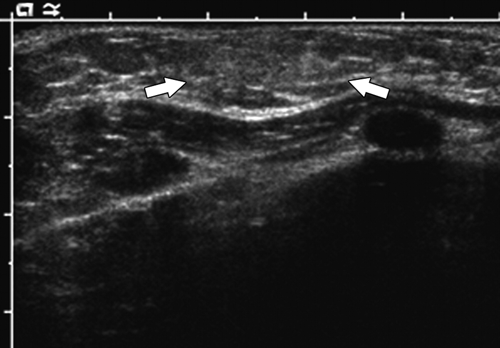
(a) Tanner stage 1 appears as a small area of ill-defined echogenic tissue in the retroareolar region (arrows).
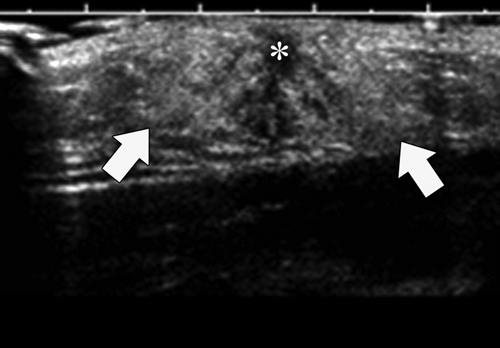
(b) Tanner stage 2 is characterised by an echogenic nodule with a retroareolar, stellate, hypoechoic focus (*).
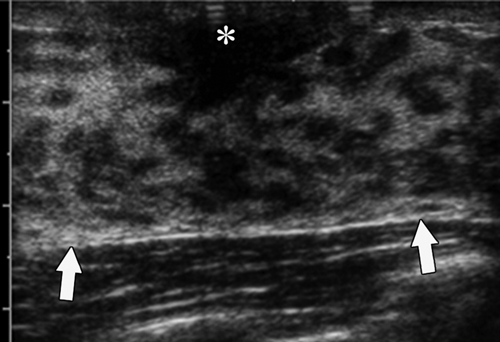
(c) Tanner stage 3 demonstrates more echogenic, glandular tissue (arrows) with a central spider-shaped hypoechoic focus (*).
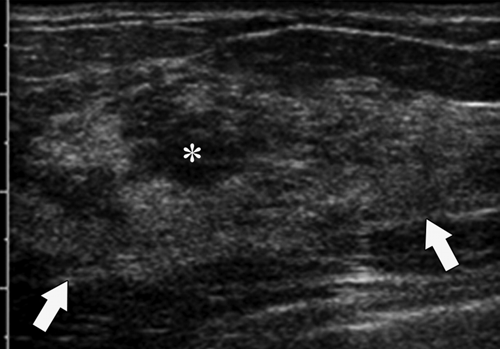
(d) Tanner stage 4 shows more echogenic fibroglandular tissue (arrows) with a central hypoechoic nodule (*) with increased subcutaneous fat anterior to the glandular tissue.
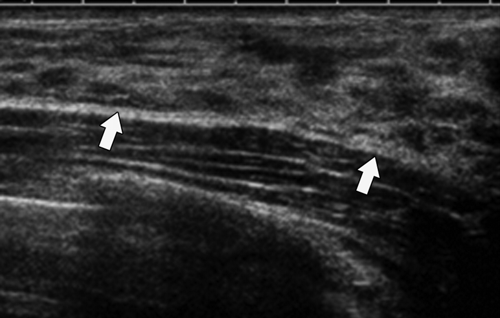
(e) Tanner stage 5 demonstrates echogenic fibroglandular tissue (arrows) without a central hypoechoic focus.
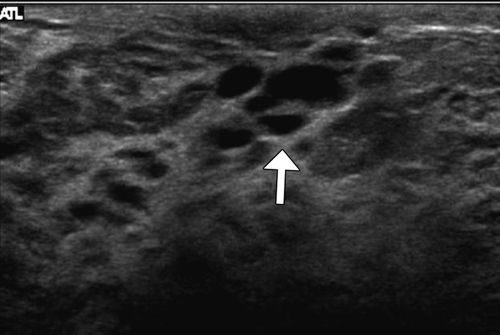
Figure 2. Unilateral gynaecomastia proved after excision biopsy in a 17-year-old adolescent who admitted frequent use of marijuana. Ultrasound scan shows a biconvex focus of decreased echogenicity (arrow) compared with adjacent subcutaneous fat, deep to which is the pectoralis muscle with hypoechoic muscle bundles separated by linear echogenic fascial bands (arrowhead).

Figure 3. Retroareolar duct ectasia: Ultrasound scan demonstrates dilated anechoic ducts (arrow) seen in cross section deep to the areola.
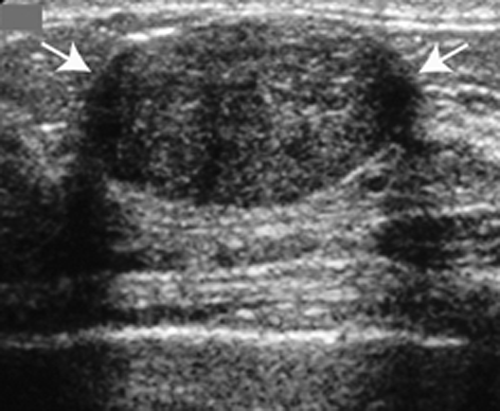
Figure 4. Fibroadenoma seen on ultrasound as a well circumscribed, hypoechoic nodule with dorsal enhancement and a long axis parallel to the chest wall.
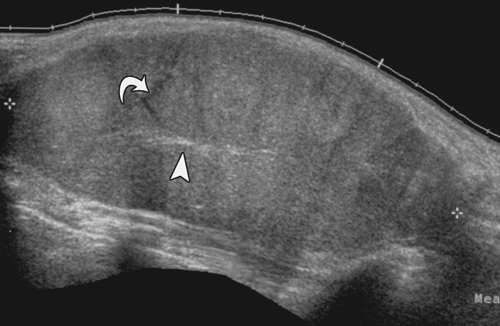
Figure 5. A juvenile fibroadenoma seen on ultrasound as a well circumscribed, homogeneously hypoechoic mass (straight arrow) within the fibroglandular breast tissue (*), with the pectoralis muscle deep to the mass (curved arrow).
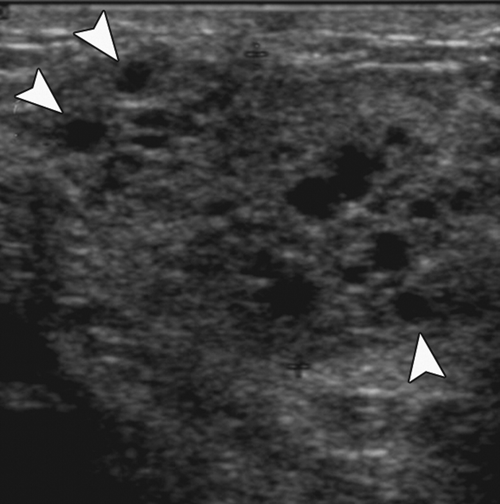
Figure 6. Juvenile papillomatosis appears as a slightly hypoechoic mass that contains multiple, small anechoic cysts (arrowheads) on ultrasound.
Figure 7.
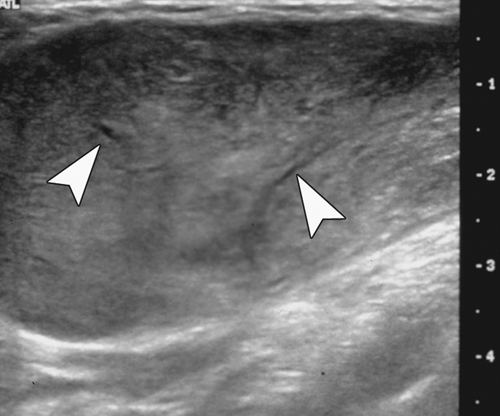
(a) Ultrasound scan of a benign phyllodes tumour reveals a fairly homogeneously hypoechoic, sharply circumscribed mass with dorsal enhancement and anechoic linear clefts (arrowheads). These findings are similar to the appearance of a juvenile fibroadenoma.
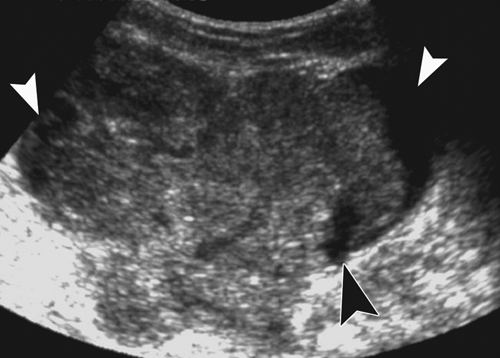
(b) Ultrasound scan of a malignant phyllodes tumor reveals a partially circumscribed hypoechoic mass with posterior sound enhancement and anechoic foci (arrowheads), some of which are round and others are curvilinear.
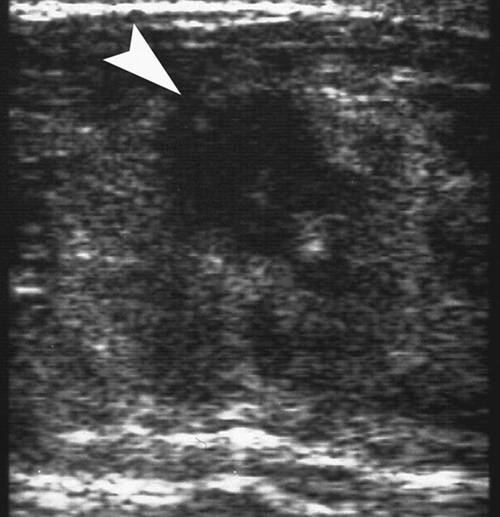
Figure 8. Secretory breast cancer: Ultrasound scan reveals a hypoechoic mass (arrowhead) with irregular borders and an anti-parallel growth pattern.

